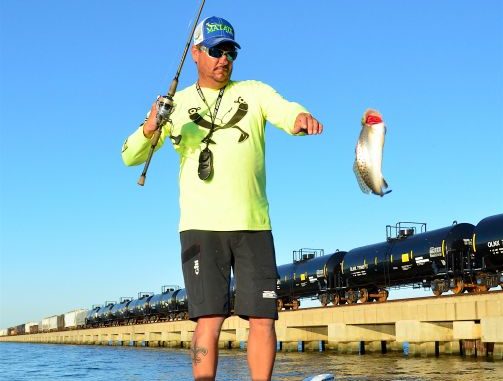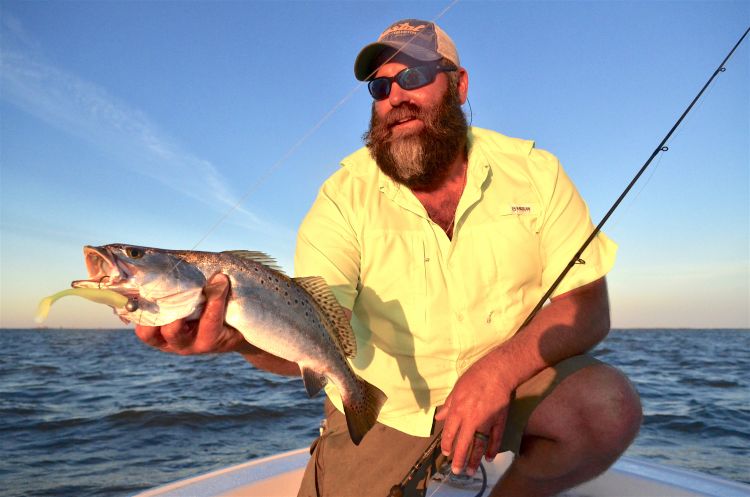
Two experts weigh in on when to use each
On Lake Pontchartrain, Capt. Matt McCabe uses the lightest fluorocarbon he can get away with, and that usually means 10-pound-test, but sometimes it’s down to 8.
Down around Buras, Capt. Lloyd Landry scoffs at anything other than braided line.
So when it comes to catching trout, who’s right?
They both are. Earlier this week I ventured to both Pontchartrain and Buras to see how these pros operate. To see Facebook Live videos from these trips (with fish catches!) click here and here.
Pontchartrain pressure
McCabe guides on Pontchartrain out of Slidell. The giant lake sees far more than its share of pressure, and much of it is concentrated in the thin concrete strips that span the huge waterbody. These are the Trestles, the Hwy. 11 bridge and the Twin Spans of Interstate 10.
“If this were a Saturday with conditions like these, there would be 300 boats along here, no question,” McCabe said.
Fortunately it was Tuesday and competition for spots was sparse. Despite the perfect 5-knot breeze and dropping tide, the fish were fickle biters right out of the gate. They were also out from the pilings 15 or so yards instead of hugging the structure. McCabe was throwing a Matrix Shad paddletail lure on a 3/8-ounce jighead.
He’s an accomplished tournament bass fisherman, which explains his painstaking attention to detail. On days with decent current he throws his bait a few feet in front of a piling and lets it fall. Trout are fond of salty water, and saltwater is heavier than fresh, so the saltiest is found on the bottom, as are the specks. One glance at the belly of a captured fish revealed a red and scratched belly.

“They’re down there in eddies behind the pilings, which is why I fish all the way back to the boat; that eddy isn’t right next to the piling, it’s back a ways,” McCabe said. “I tell people to work it like a jig-and-pig or a worm. You kind of lift it and drop it or hop it a few times before reeling.”
His preference for light line harkens back to his bass days. He uses the lightweight fluorocarbon because the lake’s fish are so pressured. Fluorocarbon is nearly invisible in water because it doesn’t refract light like monofilament does. Plus, it’s more sensitive than mono because it’s stiffer.
Once he got into a rhythm, McCabe was busting trout more often than any other boat in sight, likely due to his tackle selection and laser-like focus on finding specks. We fished on the east side of the bridge while most everyone else was on the west.
“All the live bait guys fish on the west side, and they’re right in doing so,” he said. “It’s the weirdest thing, but it’s rare to get bit on the east side with live shrimp. Some guys also fish the shade line, but I do well back here in the eddies.”
We worked south, scratching out a total of a dozen trout and a drum in three hours fishing. McCabe has been guiding on the lake for four years and has a first-rate rig and all the knowledge you’ll need to put some famed Trestles trout in the boat.
He can be reached at Pro Edge Fishing Charters on Facebook or at 985-640-0207.
Buras beatdown
Contrary to McCabe, Lloyd Landry wonders why anyone would own or spool up with anything other than braided line. (I can only imagine what he was thinking as I broke off jighead after jighead on the Empire jetties while using 15-pound fluorocarbon.)
After fishing with McCabe, I headed south to go out with Landry for an afternoon around Buras to see if we could scare up some specks. But with the wind blistering out of the southeast, initially we had to punt and chased some redfish around the jetties.
After hooking up with a keeper, he horsed it in within a matter of seconds and brought it upstream in a scathing current.
Interestingly, his bait of choice was the same as McCabe’s — a Matrix Shad (chartreuse with a white tail) rigged on a 3/8-ounce jighead. I was set to do a Facebook Live video with him and didn’t have much for cell signal, so we headed to Lake Washington to try a shallow rig and to see what Verizon had to offer there.
The signal was great, so the show was on. We anchored upcurrent of a line of rocks and before I could get the camera rolling Landry found a willing trout. Throughout the episode he boated several keepers and we walked away with a dozen for the afternoon. Not bad considering the conditions — but hey, the man is a professional.
The key to finding fish in Buras this time of year is paying attention to the conditions and water clarity. Naturally you’ll want to match your tackle to complement these variables.
For Landry, that means braid on casting gear. Many anglers get spun out if the water is dirty, but not Landry. He points a gem of advice his pairran gave him years ago referring to fishing dirty water: “You don’t move when your house is dirty, do you?”
He said a color change is sometimes all that’s needed to to turn the bite back on. The dingy water was why he was throwing a bright chartreuse color. Darker water also leaves line less visible, which is another reason he prefers braid.
The bottom line is that you need to size up where you are, what you’ll be fishing for and where the quarry lives when it comes to choosing your tackle and the right line.
To get in touch with Landry, call 504-912-8291 or find him at Outcast Fishing Charters.


